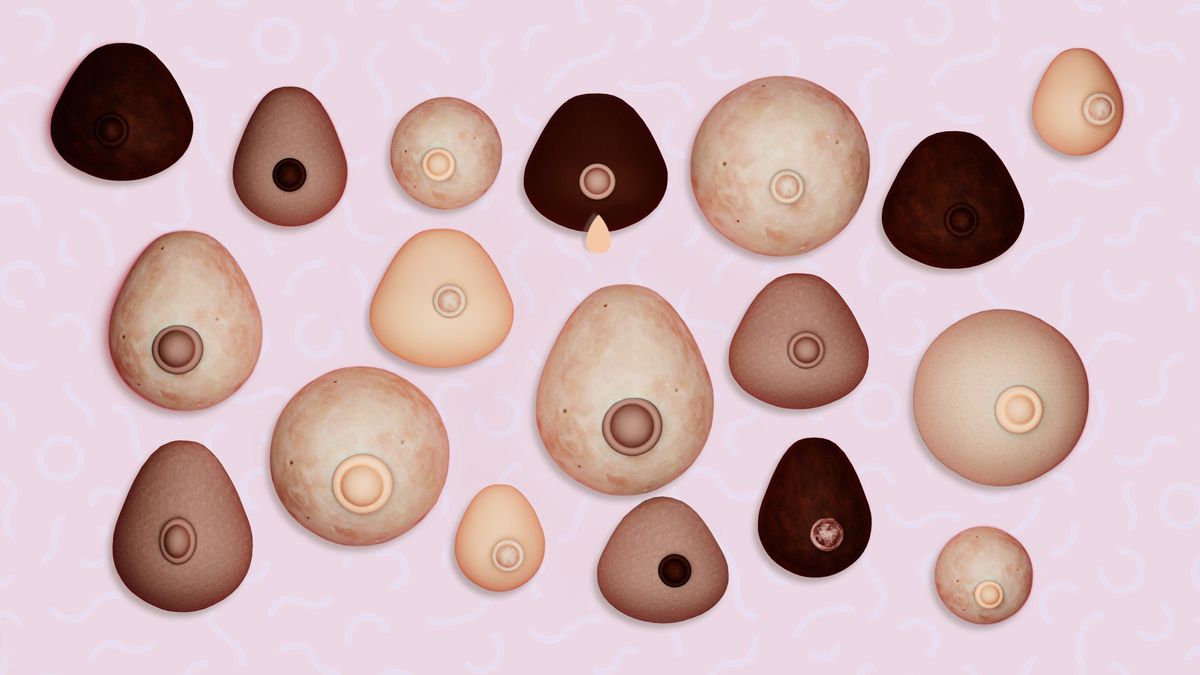When you think about a body part that leaks, you probably don't think of your nipples—but leaking fluid from the breasts is more common than you might think. Up to 80% of those with breasts who aren't pregnant or breastfeeding experience discharge from their nipples, and while most causes are benign, it's important to be aware of the different types of nipple discharge so you can take care of your health.
Anatomically, breasts are meant to contain fluid. Along with fatty tissue, every breast contains around 15 to 20 milk ducts, which are like routes from inside of the breast to the nipple. "This is the part of the breast that brings fluid to the nipple and could result in discharge," says Carla Fisher, MD, director of breast surgical oncology at Indiana University Health.
RELATED: 20 Things You Need to Know About Your Nipples
If you're not breastfeeding, you can still experience discharge from one or both nipples. Some types of nipple discharge are unproblematic, while you should get checked out by a doctor if you're experiencing other types. Here's what you need to know about the different types of nipple discharge, according to breast specialists.
Types of nipple discharge
Physiologic nipple discharge
Broadly, Dr. Fisher says there are two types of nipple discharge. Physiologic discharge is usually related to something systemic going on in a person's body. Typically, it comes from both breasts and can come out of multiple ducts (which she describes as pinpoint holes in the nipple). Physiologic discharge is usually non-spontaneous, which means someone has to elicit the discharge themselves. "Some women describe feeling tenderness behind the nipple that can be relieved by squeezing it," Dr. Fisher says.
Kimberly Sue Stone, MD, a general surgeon specializing in breast surgical oncology with Stanford Health Care, says physiologic discharge is usually clear, milky, green, or brown, and it can stem from a number of causes.
Sometimes, if people recently breastfed but stopped, Dr. Stone says milk-like fluid can come out with nipple stimulation. There's another condition called galactorrhea, in which people produce milk when they're not breastfeeding, that could be caused by adrenal problems. Some medications, Dr. Stone adds, can also cause people to create and leak milk even when they're not breastfeeding and haven't recently.
RELATED: Here's What Inverted Nipples Say About Your Health
In other people, physiologic breast discharge is just a part of getting older. Lori Fredrick, MD, a breast radiologist at the University of Oklahoma Health Breast Health Network Edmond, says older people can experience dilation in their breast ducts as they age, which can cause the nipples to leak a green or brown fluid. "It's nothing we worry about, but because it's being held right behind the nipple, it might leak out," Dr. Fredrick says.
Pathologic nipple discharge
Pathologic discharge, on the other hand, may stem from something that's inside the breast. Usually, Dr. Fisher says, medically concerning discharge comes from just one breast, or a single duct in that breast. It also tends to be spontaneous, which means it comes out on its own without nipple stimulation. "Patients say they take off the bra at the end of the day and notice fluid in it," she says.
Usually, Dr. Fisher says, pathologic nipple discharge is clear or bloody; intraductal papillomas, cauliflower-like masses in the breast ducts, are a common cause. Not all papilloma growths are cancerous, but Dr. Fisher says about 10 to 15% of them may harbor a malignancy or precancerous cells. According to Dr. Stone, doctors tend to remove papillomas to avoid cancer.
Nipple discharge and breast cancer
Most nipple discharge, Dr. Fisher says, isn't associated with breast cancer, but clear or bloody nipple discharge can be a symptom of breast cancer in some people. "It's not necessarily indicative of cancer, but if there is cancer there, it would be bloody or clear, spontaneous, and only in one breast," she says.
Blood from a cancerous growth in the breast would be bright red, but other times, Dr. Stone says the nipples may discharge older, dark brown, or blackish blood. If you're not sure whether your nipple discharge contains blood, your doctor can take a sample of the fluid and examine it under a microscope.
It's worth noting that bloody fluid from the nipple is usually an early symptom, when it is a symptom. "Even if it's breast cancer, if you experience bloody discharge, it's usually early stage and non-life threatening," says Dr. Fredrick.
RELATED: What Is Breast Cancer?
While bloody discharge should generally prompt people to visit the doctor, it's not always something growing inside the breast. Dr. Fisher says breast ducts can also leak blood after an outside trauma, like an accident or injury.
What to do if you have nipple discharge
If you have nipple discharge you're concerned about, your doctor can help you determine the cause. Before they order any tests, Dr. Fisher says a doctor will ask you whether the discharge is persistent. If you've only noticed it once or twice, your doctor may tell you to keep an eye on it.
If they're concerned it could be pathologic, they may send you for a breast exam. Breast imaging, like an MRI, can show your doctor your breast ducts so they can determine if there's a mass. If there is a mass present in the breast, Dr. Fisher says she'd refer a patient to a breast surgeon for further evaluation.
While the majority of nipple discharge isn't related to anything serious, it's worth visiting your doctor for peace of mind if you're worried. "It's never too soon to talk to a doctor if you're concerned," says Dr. Frederick. "We want to ease your mind and help you understand what's concerning and what's not."
To get more stories like this delivered to your inbox, sign up for the Healthy Living newsletter
